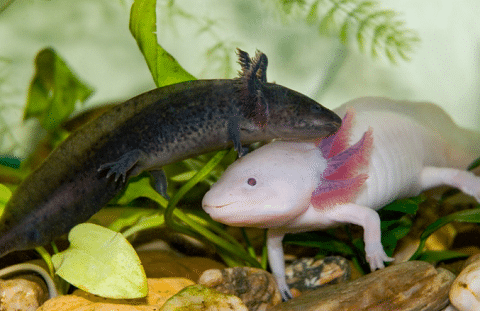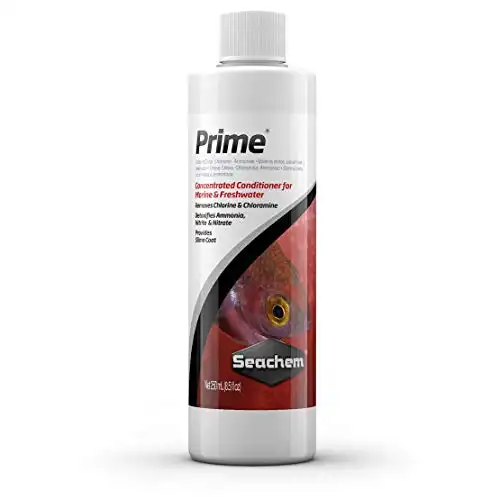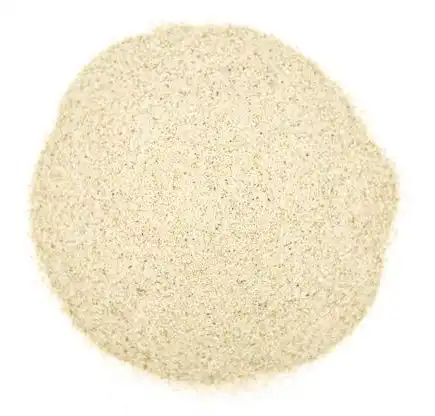Thank you for visiting! By the way… any links on this page that lead to products on Amazon and other stores/partners are affiliate links Aquarium Store Depot earns a commission if you make a purchase.
Axolotls are hardy salamanders that live underwater permanently. They are easy to care for and typically live in captivity for around 10-15 years. However, most novice aquarists wonder how long do axolotls live.
The answer is pretty straightforward. As long as you provide your Axolotl with the right environment, food, tank size, and conditions, they will live for around 20 years or even longer. So, keeping an axolotl as a pet is a long commitment that demands dedication.
Unfortunately, axolotls are almost extinct in their native habitat. And so, what we get here is the laboratory-bred and tank bred axolotls that live much longer than the native ones.
But before diving straight into the topic, let’s discuss why axolotls are endangered?
Why Are Axolotls Endangered?
Axolotls are critically endangered species, which are constantly declining in the wild and might go completely extinct in the near future.
There are a number of factors that resulted in their sharp decline. In 1998, research stated that there were 6,000 axolotls per square kilometer in the lake Xochimilco. However, today, the axolotl population dropped to 35.
So, where did we go wrong? The video above goes in detail (video from Frankie’s Aquatics). I’ll also add my points below. Let’s find out.
Water Contamination
The advancements and developments anywhere bring their own consequences. Thus, the recent developments in the Xochimilco regions resulted in water pollution, making these areas havoc for aquatic animals, especially axolotls.
Overfishing
It’s an old story of supply and demand; when the Mexican walking fish became a supreme delicacy in Mexico, the demand increased, leading to overfishing. And so, the numbers of axolotls in the wild kept decreasing.
Habitat Loss
The recent expansion of Mexico city almost completely destroyed and drained the lake Xochimilco, one of the principal habitats of axolotls.
Invasive Species
Mexicans introduced a number of invasive species in Lake Xochimilco that have decimated axolotls numbers in the wild, ultimately contributing to their shape decline. Axolotls themselves are considered invasive in some areas, with efforts from local government to make them illegal to own.
How long do axolotls live in their natural habitat?
It would surprise you that axolotls only live for about five to six years in the wild. And that’s because these species are endangered in their natural habitat due to habitat loss, fatal illness, or predators that prey on them.
Therefore, axolotls live for around five years to six years in the wild.
How long do they live in captivity?
Even though we don’t have solid numbers for the oldest-known Axolotl, axolotls can live for up to 15 years in captivity. Some may even go for 20 years and longer if taken care of.
Therefore, adopting an axolotl is a huge commitment that demands consistency and dedication.
Factors that affect Their Lifespan

Like other salamander species, Axolotl’s life span mainly depends on the following factors. You can increase your axolotl life span by considering these factors and keeping them happy and healthy for an extended time.
1. Water Quality
If there is one thing that Axolotl cannot compromise, it is the tank’s water quality. Your axolotl tank’s suggested optimum water temperature is 59°F to 60°F (16-18°C). As an estimate, the water temperature should not exceed 75°F (24°C).
Additionally, the pH level of the water tank should be 7.4 – 7.6 to create a warm, welcoming environment for your smiley little pets. To increase Axolotl lifespan, your axolotl tank should be free of Chlorine and chloramines as they are harmful to your pet axolotls.
If Chlorine is detected in the water, I suggest installing a de-chlorinator to minimize the effects. Also, to get rid of the traces of Chlorine, water should be left standing for at least 24 hours before adding your Axolotl.
Seachem prime is a easy to use and affordable choice when it comes to remove chlorine and chloramines from your tap water. Highly recommended!
2. Tank Setup and Conditions
Axolotl spends their entire lives underwater, so their only home is the tank in which they live. Make sure to reward your adorable pets with the best and high-quality tank setup and conditions.
First of all, the tank size should suffice the needs of your Axolotl. The bare minimum tank size to house one juvenile axolotl is 10 gallons. However, the tank size should be no less than 20 gallons for adult axolotl. That’s because axolotls are solitary creatures, more like messy creatures that create a lot of waste. Thus, a small tank would create serious health problems in the long run.
Secondly, it is advised to change the tank water frequently to avoid bacterial and fungal infections. Also, water changes helps keep the ammonia levels low. Suppose you’re someone who cannot commit to changing the water regularly. In that case, I suggest installing canister filters as the water flow in canister filters is regulated to prevent stress-related diseases in your pet axolotl. Also, I don’t recommend plants in an axolotl tank as your pets might destroy them, causing a lot of mess in the tank. If you must, consider soft and flexible plants so your axolotls can pass through them quickly. I suggest keeping Java ferns for axolotl tanks.
Lastly, the best choice for the substrate is sand since the particles are soft and small and cause no potential damage if swallowed.
Natural sand is excellent for bottom feeder fish to forage around in.
Additionally, there is absolutely no need for proper lighting in the axolotl tank. The fact that these creatures lack eyelids, intense lighting is quite stressful to animals. Also, they are nocturnal animals and enjoy the darkness. If lighting is a requirement for your plants, you can invest in an L.E.D. Bulb for your aquarium. Many pet stores stock such lights, which are dimmable and fully adjustable.
3. Food
Axolotls are carnivorous and voracious eaters that eat pretty much anything that comes their way. However, it’s essential to feed them nutritious food rich in proteins to extend axolotl lifespan. Axolotls feast on live food such as earthworms, bloodworms, blackworms, brine shrimp, salmon pellets, etc. However, juvenile axolotls can eat daphnia, white worms, and grindal worms. You can also hand-feed your Axolotl to experience an adorable pet-parent moment.
4. Handling
Axolotls are part of the salamander family are aloof in nature and like to mind their own business in a peaceful, stress-free environment. Therefore, minimal handling is required for axolotls, especially if you want them to live a happy, healthy, and long life.
Of course, you cannot avoid handling, especially while checking their skin or changing water, but it shouldn’t be done routinely. You can also keep Axolotl out of the water, although it is not recommended at all. That’s because axolotls have a slimy coat on their body which might be destroyed by your hands, posing a threat to contact bacterial infection. Therefore, keep your axolotls in water and unbothered for a longer lifespan.
5. Tank Mates

Axolotls are like your introverted friends that love you but stay low-key. So, if you want to house other pets with your Axolotl, think again!
Axolotls are nocturnal animals, and they can easily harm other sleeping fish for a healthy meal. Here, I’m going to list the best axolotls tank mates for your convenience.
- Other Axolotls (Best choice as long as they have enough space and are of equal size)
- Small Shrimp (ghost shrimps)
- Guppies
- Mini soft-shelled snails (Ramshorn snails)
- White cloud minnows
- Other species of peaceful cool water fish
However, bear in mind that you would at least need a 55-gallon tank if you plan on keeping tank mates with your Mexican walking fish.
FAQs
Can you touch them?
Although not recommended, you can touch your axolotls in the case of emergency and urgency, i.e., while changing tank water or checking for diseases and other problems. But, handling your axolotls shouldn’t be a routine task as it is much more stressful for the pet.
Also, axolotls have a slimy coat on their skin, which might damage by the warmth of your hands, posing a severe threat to your axolotls.
How long can they be out of water?
Not so long. Axolotls can survive outside of water for a few minutes, and as soon as they dry out, things can get pretty ugly.
Axolotls’ skin is covered with a slimy coat that protects them from danger and other fungal and bacterial infection. If axolotls are out of water for too long, this coat disappears, leaving the pet in danger.
Are they good beginner pets?
Yes and no.
Axolotls are good beginner pets as they live underwater and require little to no handling. It also means that they don’t need any special care and attention. However, they are susceptible to stress-related diseases. Hence, this is why I don’t think they are a good choice for beginners.
Axolotls are very sensitive to water quality and conditions. Most axolotls spend their lives in a stressful environment just because the owners don’t care enough about their surroundings.
Therefore, if you’re a responsible novice keeper and plan to provide the proper water parameters, tank size, and optimal tank conditions to your axolotls, yes, axolotls are good beginner pets for you.
Can they live for 100 years?
No, axolotls live for around 10-15 years in captivity. The longest they can survive is approximately 20 years when the Axolotl is well-cared of in some rare cases.
How long do these pets live?
Pet axolotls live for around 10-15 years in general. In some extreme cases, when provided the suitable water parameters, conditions, and tank size, axolotls can live for up to 20 years.
Are They Immortal?
No. Axololts die naturally due to natural threats. In most cases, several factors contribute to their sudden, accidental death, such as inferior water quality, food that contains toxins and are hard to digest. The primary cause of axolotl death is overheating. Therefore, an aquarium chiller is recommended for axolotls’ tank.
Axolotl lifespan is around 10-15 years with proper care, which is known to be the longest as compared to other aquatic animals.
Can They regenerate body parts?
Axolotls have the power to regenerate their body parts and internal organs such as limbs, lungs, heart, and brain.
Their ability to regenerate limbs and other organs is the prime reason for their extended life expectancy. Because if they are exposed to diseases or accidents, they will regenerate, and the organs come back to their original state.
How are axolotls different from other salamanders?
Axolotls are different from other species in a variety of ways.
1. Axolotls are larger than other species.
2. Axolotls are only native to Lake Xochimilco, whereas other species can be found elsewhere.
3. Unlike most amphibians, axolotls are neotenic, which means they don’t undergo metamorphosis, and their juvenile features are retained in the adult animal.
4. Axolotls live entirely underwater and use gills for breathing.
What causes Their death?
Like other animals, axolotls die naturally. However, there are instances when they have an accidental death.
The leading causes of Axolotl’s death are poor water quality, smaller tank size, high temperature, and unsuitable mates for your axolotl pets.
To allow your axolotls to lead a happy, healthy life, it is imperative that you provide them with the right water parameters and conditions. Also, the quality of food should be superior. It is recommended to install an aquarium chiller or aquarium fans to main the water temperature.
Final Thoughts
So the answer to how long axolotls live is no longer a mystery. Axolotls, in captivity, can live for up to 10-15 years. Some may live longer for up to 20 years, provided their water and tank requirements are met.
Axolotl lifespan wholly and solely depends on how you keep it. Proper axolotl care includes tank size, water quality, food quality. If you get that all right, your smiley little pets will live longer and happier with you.
- About the Author
- Latest Posts
I’m thrilled that you found Aquarium Store Depot! Here you’ll find information on fish, aquariums, and all things aquatics related. I’m a hobbyist (being doing this since I was 11) and here to help other hobbyists thrive with their aquariums! I adhere to a high quality Editorial Process and Review products with real life field usage and practical analysis.







